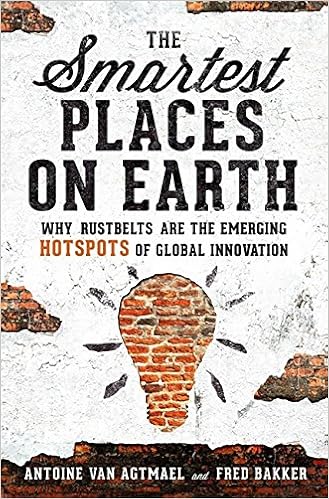 America never stopped being great and we are about to become greater again. Competition, automation and the 2008 crash followed by a weak recovery have made us feel less down and fueled anger, but we are at an inflection point again with indicators pointing up. In some ways, the situation today is like that of the late 1970s or early 1980s. We lived through a years of uncertain recovery and “malaise” but good things were happening that were easily overlooked.
America never stopped being great and we are about to become greater again. Competition, automation and the 2008 crash followed by a weak recovery have made us feel less down and fueled anger, but we are at an inflection point again with indicators pointing up. In some ways, the situation today is like that of the late 1970s or early 1980s. We lived through a years of uncertain recovery and “malaise” but good things were happening that were easily overlooked.I went to CSIS to hear the authors of “The Smartest Places on Earth” talk about their new book. Antoine van Agtmael & Fred Bakker spent three years studying a type of manufacturing renaissance now happening in the U.S. and parts of Western Europe. It will not b
e a return to the old order industries. This is not ever coming back. The jobs were not shipped overseas; they are gone forever, often replaced by automation or changed processes. So what is this renaissance?
We cannot compete with cheap. Emerging markets can always undercut price. We can compete on smart and fast. Smart people using technology to innovate new products can more precisely and quickly satisfy the changing desires and demands of usually closer consumers. The new paradigm replaces that hierarchies, specialization and walled gardens of the past with collaboration, open cooperation and multidisciplinary approaches. What counts most are the connective tissues, the seams between factors are what makes things work. They need a connector to orchestrate.
We cannot compete with cheap. Emerging markets can always undercut price. We can compete on smart and fast. Smart people using technology to innovate new products can more precisely and quickly satisfy the changing desires and demands of usually closer consumers. The new paradigm replaces that hierarchies, specialization and walled gardens of the past with collaboration, open cooperation and multidisciplinary approaches. What counts most are the connective tissues, the seams between factors are what makes things work. They need a connector to orchestrate.
The base of the new economy is the old industrial expertise using new materials, information technologies and big data. This has transformed some of the rust belt into what the authors call the brain belt. They are in unlikely places, like Akron, Ohio, which is transformed from “rubber city” to a polymer capital.
Necessary components of such transformations are: a life threatening crisis as stimulant; good universities nearby; complex, multidisciplinary challenges; openness to sharing brainpower; a connector with local political support; infrastructure including cheap housing and access to venture capital. One more thing that seems necessary is location in the U.S. or Western Europe.
Russians, Chinese, Saudis and others have tried to create such innovation clusters w/o success. They can build all the stuff and bring in experts, but what they seem unable to do give people the mindset of free thought and freedom of fear of failure.
Innovation is bottom up but, like the free market, it requires lots of help from the top, i.e. government. This comes NOT from management but rather in support of good and consistent laws, support for basic research and general infrastructure. One of the bases of American prosperity was laid in 1862 with the Morrill Act that established land-grant universities with the mission of fostering the useful arts and sciences. More recently was the 1980 bipartisan Bayh-Dole Act that allowed universities to profit from inventions they helped create, even when they received Federal funds. This had immediate effects on technological advances in things like information technology and life sciences. It took a bit longer with the manufacturing. One reason this is happening now is that information technology makes prototyping much cheaper. It used to cost millions to make a prototype. Today it can be done for some thousands.
Another characteristic of new centers of innovation is that they are urban. The old paradigm has campuses isolated from each other where researcher worked with specific plans. The new centers are mixing it up. This is cultural to some extent. Young people like good restaurants and places to meet. However, it also relates to the multidisciplinary approach and maybe the need for serendipity. People with different backgrounds need to interact often in ways nobody predicts. Proximity counts.
I bought the book and the author signed it, so I will read it and know more details. In many ways it sounds like innovation of the past, of course there is always a new twist. One reason why the industrial revolution happened is that doers and thinkers mixed in ways previously uncommon. The interaction between them is a key to innovation. Our paradigm of somebody planning and then somebody making is wrong. It is more often a feedback loop with a product sometimes coming before the idea, odd as this sounds. It is often better to try something out even before you think it through.
I see most things in ecological terms. And as I thought about the subject of innovation, I recalled the trips I had taken to the U.S. to work with the Brazilian Science w/o Borders program. I wrote about this kind of thing back then too.
Link to one of my earlier post on a similar subject.
Link to one of my earlier post on a similar subject.
